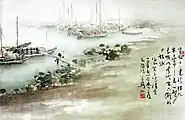Lingnan School
The Lingnan School (Chinese: 嶺南畫派) of painting, also called the Cantonese School, is a style of painting from the Guangdong or Lingnan region of China.[1]

This school reflects a style of painting founded in the 19th century in Guangdong province by Two Gaos and one Chen - Gao Jianfu, Gao Qifeng and Chen Shuren, also known as "The three greats of Lingnan" (嶺南三傑).[2]
The Lingnan style of painting was revolutionary and innovative compared to traditional Chinese painting, influenced by Nihonga visual arts and by the early Qing painter, Yun Shouping (1633–1690).[3][4][5]
In the late 19th century, scholars in China broke through entrenched conservative thoughts and began to actively seek to create and promote new schools and styles of art. This not only cultivated a large amount of ideological progress among social elites but also gave birth to the "eclectic fusion of the Han Chinese and Western style, ancient and modern" Lingnan school. The Lingnan school advocates the introduction of Western painting styles with the integration of Han Chinese and Western paintings, in the spirit of revolution of Oriental arts, while maintaining traditional Han Chinese painting techniques.
This school of painting enjoys considerable fame among Han Chinese peoples. Along with Cantonese opera and Cantonese music, they are known as the "three fineries of Lingnan" (Jyutping: Ling5 Naam4 Saam1 Sau3; Traditional Chinese: 嶺南三秀). Meanwhile, the Lingnan school is listed along with Beijing and Tianjin painting school and Shanghai school as the three pillars of modern Chinese painting.[6]
Name
The term "Lingnan School" was not coined by Lingnan painters. During their era, Gao Jianfu, Gao Qifeng and Chen Shuren, with their bold and innovative style, were given the title of "The Three Greats of Lingnan." This contributed to the formation of the name "Lingnan school". However, Chan expressed his dissatisfaction with the title "Lingnan school" as he felt that it suggested that the school was merely regional and that it did not reflect the absorption of overseas styles and the idealism of innovation in Han Chinese paintings. Gao Jianfu never used the name "Lingnan school of painting," and would rather call it "eclectic."
"Lingnan painting" refers to the work of painters in the Guangdong province in general.
Techniques
According to Wang Lipu's view, Lingnan school is characterized by:[7]
- Blank space focus: Lingnan paintings, in line with traditional Han Chinese painting styles, are focused on the "presence of both the real and the surreal", and "paying attention to the places without ink" - inheriting the traditional techniques of ink wash paintings.
- Strokes focus: Lingnan school's strokes are complex and anti-tradition, with the goal of achieving magnificence and vividness.
- Bright coloring: Influenced by impressionism, Lingnan paintings focus on the light performance. Most of the colors are very bright, in stark contrast to the traditional ink wash painting, which in turn is pale, stressing "With paleness comes the soul of pens and ink".
- Rendering of background colors: Since the Tang dynasty poet-artist Wang Wei put forward the idea that ink wash was superior,[8] In general, Han Chinese painting styles focus on the use of ink wash and abstain from coloring. Lingnan school does the opposite.
Notable artists
- Chao Shao-an (Zhao Shao'ang)
- Guan Shanyue
- He Xiangning
- Huang Junbi
- Li Jinkun[9]
- Li Xiongcai[9][10]
- Liu Chuncao[11]
- Yang Shan Shen
- Au Ho-nien
- Ho Fung-lin
- Hsin Peng Chiu
- Anita Yan Wong[12]
Gallery
 "Rain in the fishing harbor" (漁港雨), by Gao Jianfu, in 1935
"Rain in the fishing harbor" (漁港雨), by Gao Jianfu, in 1935 Flowers and birds, by Gao Qifeng
Flowers and birds, by Gao Qifeng Deer, by Gao Qifeng
Deer, by Gao Qifeng White horse, by Gao Qifeng
White horse, by Gao Qifeng
See also
References
- Croizier, R. C. (1988). Art and Revolution in Modern Japan the Lingnan (Cantonese) school of painting, 1906-1951 (Vol. 29). Univ of California Press.
- "岭南画派" (in Chinese). 2002-01-15. Archived from the original on 2014-02-13. Retrieved 2017-09-09.
- "The Art of Lingnan School, 嶺南畫派的繪畫藝術". www.lingnanart.com. Retrieved 2021-01-11.
- "Lingnan School". China Online Museum.
- Koon, Yeewan (2014). A Defiant Brush: Su Renshan and the Politics of Painting in Early 19th-Century Guangdong (PDF). Hong Kong: Hong Kong University Press. ISBN 978-988-8139-61-3.
- "岭南画派简介" (in Chinese). People's Government of Guangdong Province. 2007-09-27. Retrieved 2017-11-05.
- "王礼溥,岭南画派" (in Chinese). 2006-04-21. Archived from the original on 2007-08-10. Retrieved 2017-09-09.
- 唐,王维,《山水诀》:“夫画道之中,水墨最为上,肇自然之性,成造化之功”
- "岭南画派大师黎雄才书法在故乡广东高要展出" (in Chinese). 2011-04-22. Retrieved 2017-11-05.
- "全国政协委员、岭南画派艺术大师黎雄才逝世(附图)" (in Chinese). 2001-12-20. Retrieved 2017-11-05.
- Pan Muying (2014-02-11). "岭南画派传人刘春草辞世 两个月前仍抱恙收徒(图)". People's Daily (in Chinese). Retrieved 2017-11-05.
- "Anita Yan Wong", Wikipedia (in Italian), 2019-04-02, retrieved 2019-04-14